Alvaro Cervera was announced two weeks ago as the new Real Oviedo head coach, after his long and fantastic spell at Cadiz where he was sacked last season in January. ‘El Gafa’, as he’s commonly known, has a large experience inside the low-categories of Spain. He’s right now living life at another great football club and another encounter in the second division.
The 57-year-old lived a truly heroic spell with Cadiz, which was his most recent job at football. However, his story with the ‘Yellow Submarine’ started in 2016 in the third division of Spain, where he qualified for the play-offs in the 4th place of their group, to then win the promotion to the second tier. A massive streak of results gave Cervera in his first season with Cádiz in the second division, a play-off spot where they draw 1-1 against Tenerife in the semi-final, and the ‘canaries’ get to the final because of they were in a better position in the league.
Three seasons later, Cadiz get the direct promotion as they finished second in the league table in a fantastic season which saw them picking 69 points and only staying behind the first place for a point. After they were eliminated against Tenerife three years later, being out of a promotion spot for two consecutive seasons, Cervera did what most people thought impossible and promoted his side from the third-tier to La Liga, one of the top-five European leagues of the world, three matchweeks before the end of the campaign. The humble but gigantic squad finally were going to play in the top tier of their country.
This tactical analysis piece will be a short team scout report of Alvaro Cervera and his tactics at Cadiz. It will also be an analysis of what he can expect inside the Real Oviedo context and what he has done in his start at the club.
Cervera pragmatic playing-style
The Spaniard head coach likes to sit in a very deep and low block that is very rigid and looks to solidify the central areas, overloading them and being very coordinated in his movements to not be that separated from the defensive line. His first season at La Liga was a big display of this, being the team with less possession per match and the highest PPDA (Passes Allowed per Defensive Action), averaging almost 20 passes per 90.
This can only define one football style: A very pragmatic and defensive one that prefers to close down spaces and block the lines, to being a propositive and proactive football team that likes to play usually with the ball at their feet. However, Cervera found the way to sit in 12th place in their first campaign at La Liga, with 44 points and famous matches like their 2-1 home victory against Barcelona, 0-1 away wins against Real Madrid and Athletic Bilbao or another 2-1 home win versus Valencia. It was a really emotional and big season that ended on a high.
As we can see in the picture below, these were the formations used by Alvaro Cervera in the 2020/21 season with Cádiz, where he normally deploy a 4-4-2 on the pitch, which can also translates to a low block inside a very traditional shape that pragmatic managers looked to play when they prefer to defend rather than attack in the major part of the game, as well as attracting completely their rival to their own third, to then run in rapid attacking transitions.

Cádiz didn’t show signs of a team that can be aggressive in their decisions when playing in a compact low block. No player from the central areas looks to jump off their line and almost everyone didn’t apart from the striker partnership looking to steal the ball with their runs. Besides that, Cervera’s team looks to be static and solid with rigid movements, forcing teams to play non-dangerous passes going side-to-side and not breaking lines as they block all available zones on the pitch.
Against Real Madrid, in one of the biggest victories in their La Liga debut season, we can see how they used their 4-4-2, narrowing wingers to midfield, looking to accumulate more than six players, with strikers in front of them to create a pressing trap to the outside where the wingers and full-backs would go close to suffocate, making the rival to go back.
In the play below, Madrid tried to break lines connecting with the left winger making the run, however, the block was so coordinated that the right-back didn’t have any problem intercepting the through-ball.
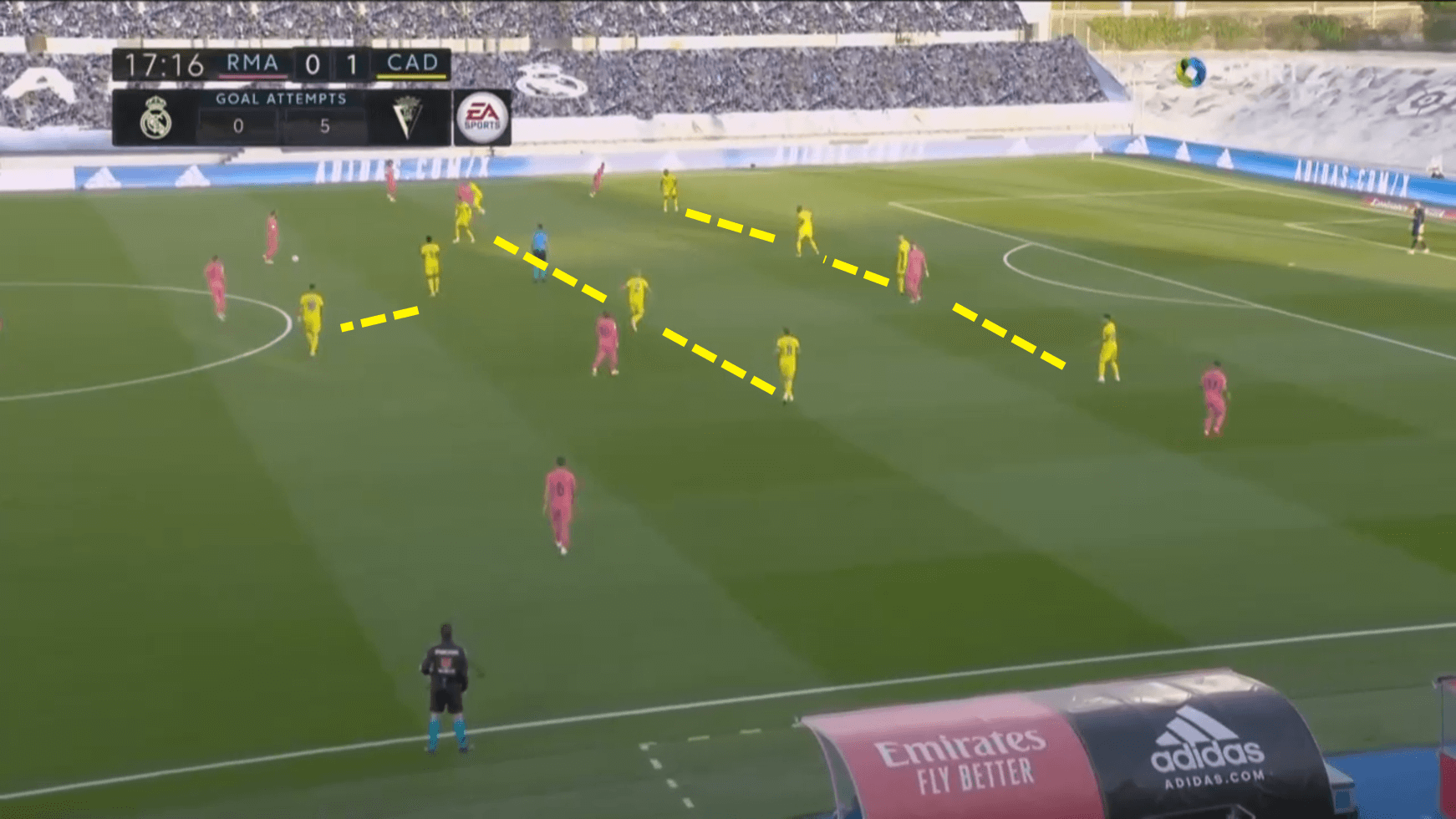
But Cervera’s Cadiz weren’t a different team in the lower divisions, as we can see that they had low ranks of possession in the 2019/20 campaign where they won promotion, as well as high PPDA that newly translates into a team that were very defensive and pragmatic.
Two years before, against Real Oviedo, without knowing they were going to be his next team after Cadiz, they could be capable of beating them at home by 2-0, with a great performance that g0t them really close to the promotion inside the last five matches of the season.
The figure below us shows the match we are mentioning and analysing, as Cádiz were approaching the 80′ minute winning 2-0 after another vital goal from Honduran centre-forward Anthony Lozano that really set the game apart, we can see the shape they were defending in. However, this was not only because of the situation, being 2-0 up, but throughout the match, they still defend in a low block, similar to the one against Real Madrid, with the only difference being that the winger of the weak-side was wider in case all turned into an attacking-transition and he could be activated with a long ball into space.
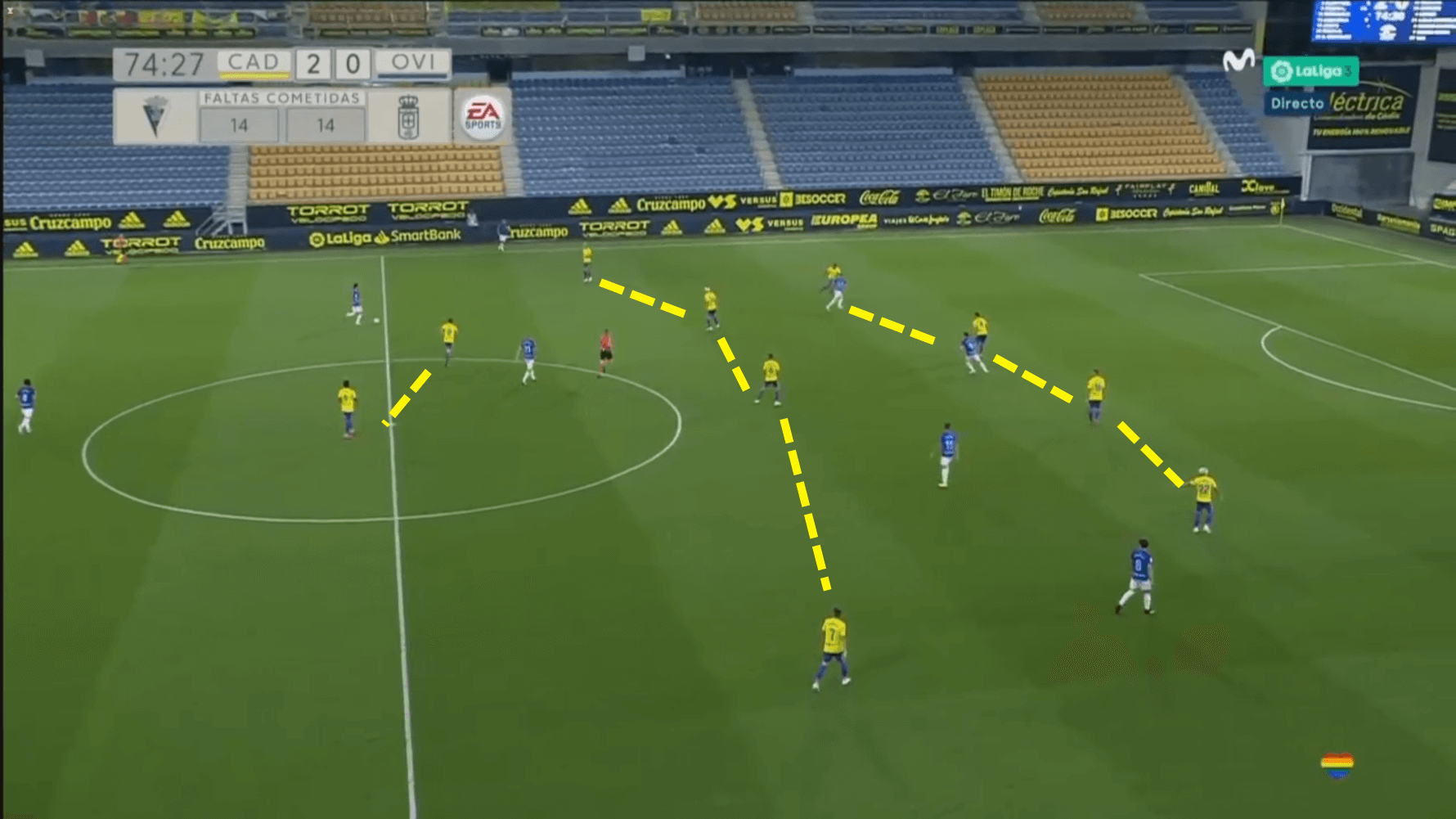
Their attacking structures were as mobile, rapid, electric and unpredictable as you would think. Wingers and midfielders commanded the build-ups that were very direct, looking to find players on the outside with long balls, but as well executing through-passes to the centre-forward that in 2-3 touches was found on a 1v1 situation against the opposition’s goalkeeper.
Although, not all the goals and attacks came from long balls to the wings, a progressive run and then a cross, lots of goals and high-goal-scoring chances were obviously like that, but Lozano’s role being aggressive to run between the centre-backs, and the other striker, a very different profile, playing more inside a target-man role holding the ball and winning it in the air, like Alvaro Negredo. These were really interesting moves and a synergic chemistry that helped Cadiz score several goals dominating possessions.
This example shows what types of situations were repeatedly seen by Cadiz, not in the final third, but more inside the process of how the goal was converted, and several steps before their celebrations. This is a typical diagonal to a player at the weak side of the ball, in this occasion, and many more, the right-winger Salvi, was targeted for these kinds of runs.
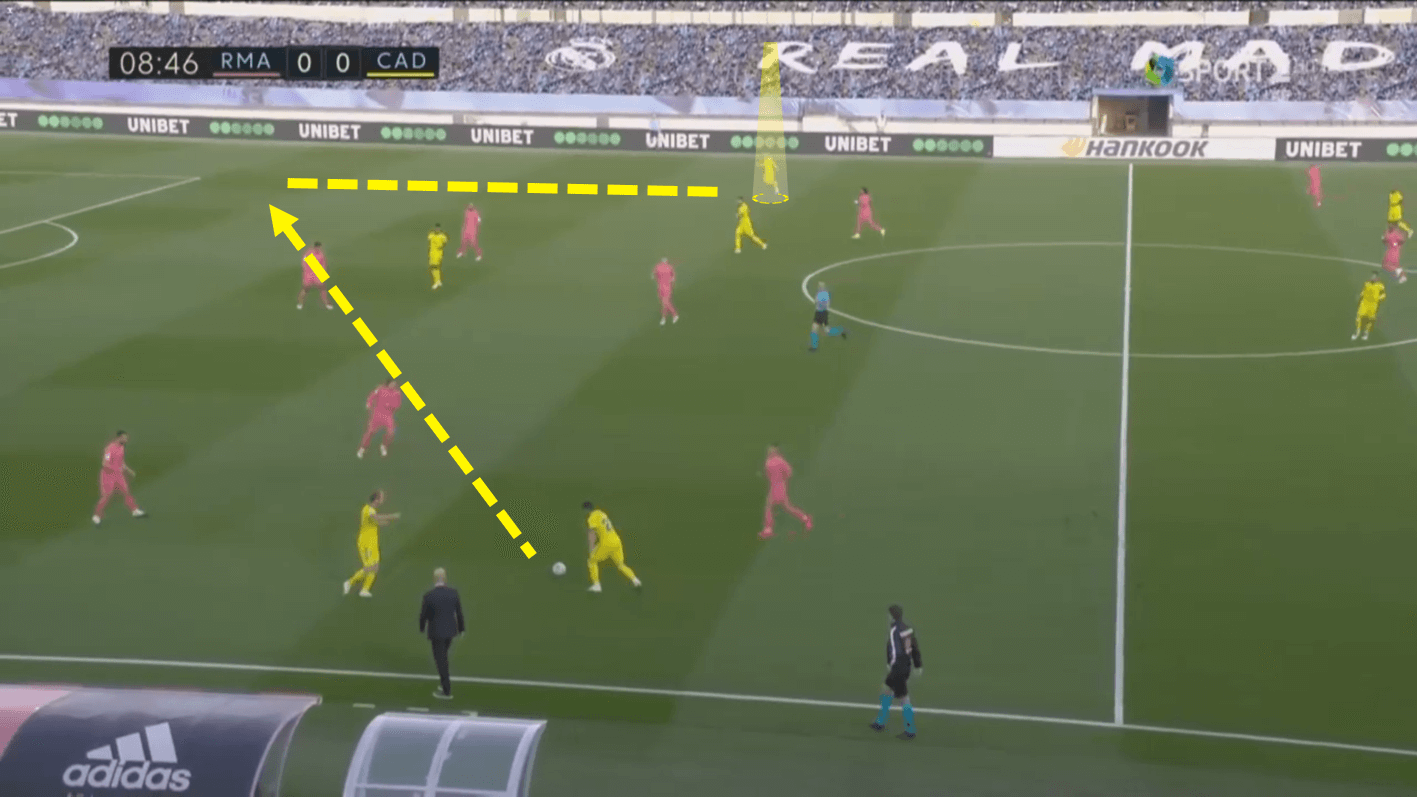
The first and only goal against Real Madrid in their heroic away triumph was like this. The right-midfielder appeared with time and space to decide where to pass it, as wingers pin very wide to open zones through the middle and to be found with diagonal balls.
Usually, the left-striker was Lozano, but this time placed himself on the right, explaining the mobility Cervera’s team had, making a rotation with Negredo that was the man that received a chipped-ball from his midfielder to then execute a delicious ball through the lines for speedy Lozano that finished the play in style against Thibaut Courtois.
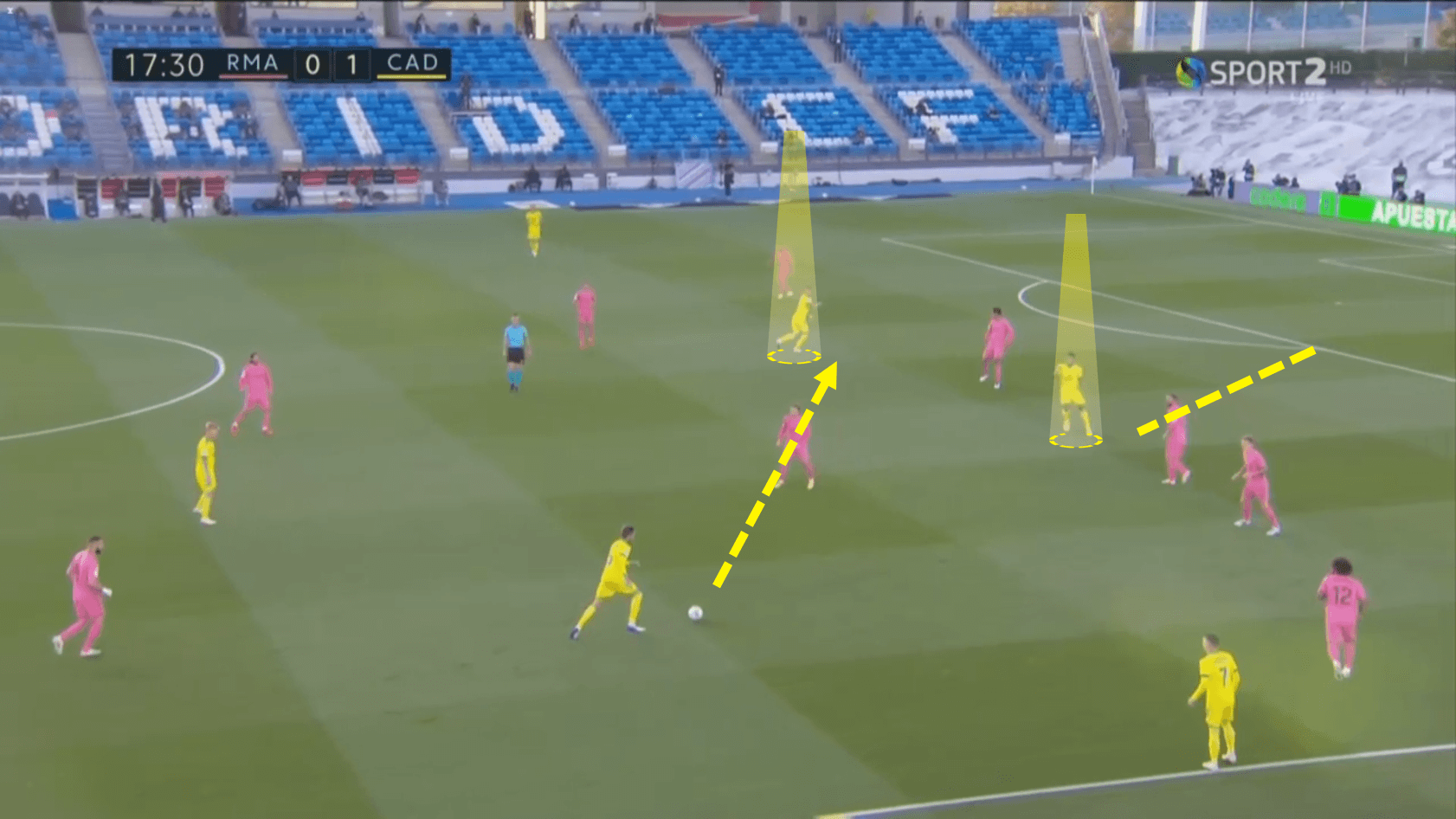
His side’s build-up also had different automatisms besides these movements from the strikers-duo, putting more emphasis on their fast wingers that had very good ball-control in their runs with the ball, going straight forward on the outside looking to cross it inside the box.
This movement was also seen in their 2-0 big victory against Real Oviedo back in the 2019/20 season, in the elaboration before their second goal, also scored by the Honduran star, Anthony Lozano. The picture below shows the previous play of it, as the midfielder released a pass to the wing, picked up by number ‘7’, Salvi, who made a brilliant run down the wing, executing a cross to the player at the far-post who inside the box couldn’t make the biggest contact with the ball, but the rebound went directly to Lozano who finished it perfect to celebrate a massive goal for his team, that later would become historic.
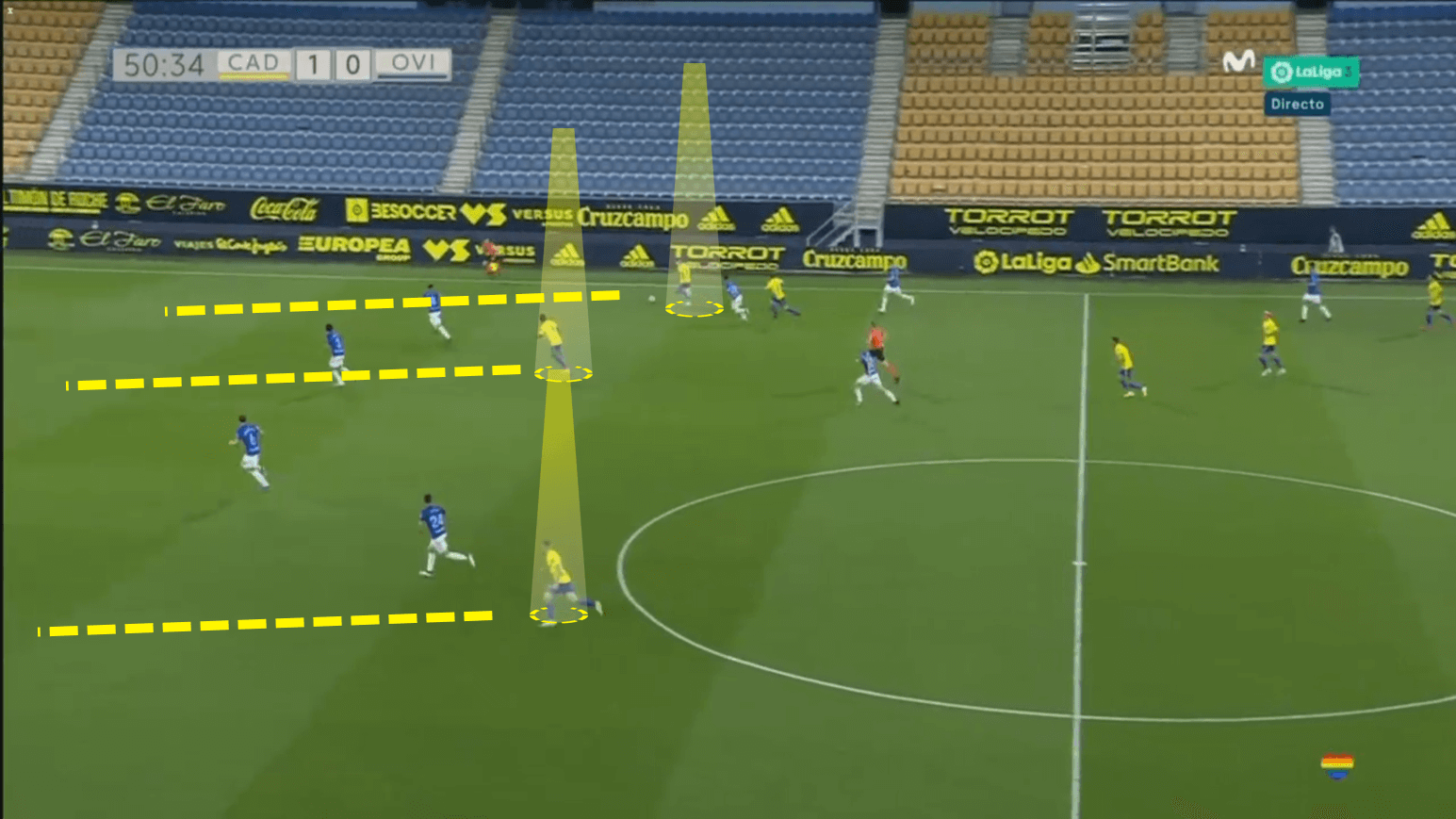
One of the traditional moves a low blocking and direct team look to apply against their rivals is attracting movements in the first stages to then release the wide and far players with long balls to run in-behind defenders.
Again, we can see this one is executed to the right wing, where Salvi is once again the key of the play, appearing into the space, running with the ball and sending a cross to the Real Madrid box, which is then anticipated by Alvaro Negredo with a header. However, it shows again their automatisms to score goals and create chances. It is simple, but if they are well-executed, with that pinch of improvisation and dynamism from all the items inside the play, they could be really dangerous in the defensive transitions.
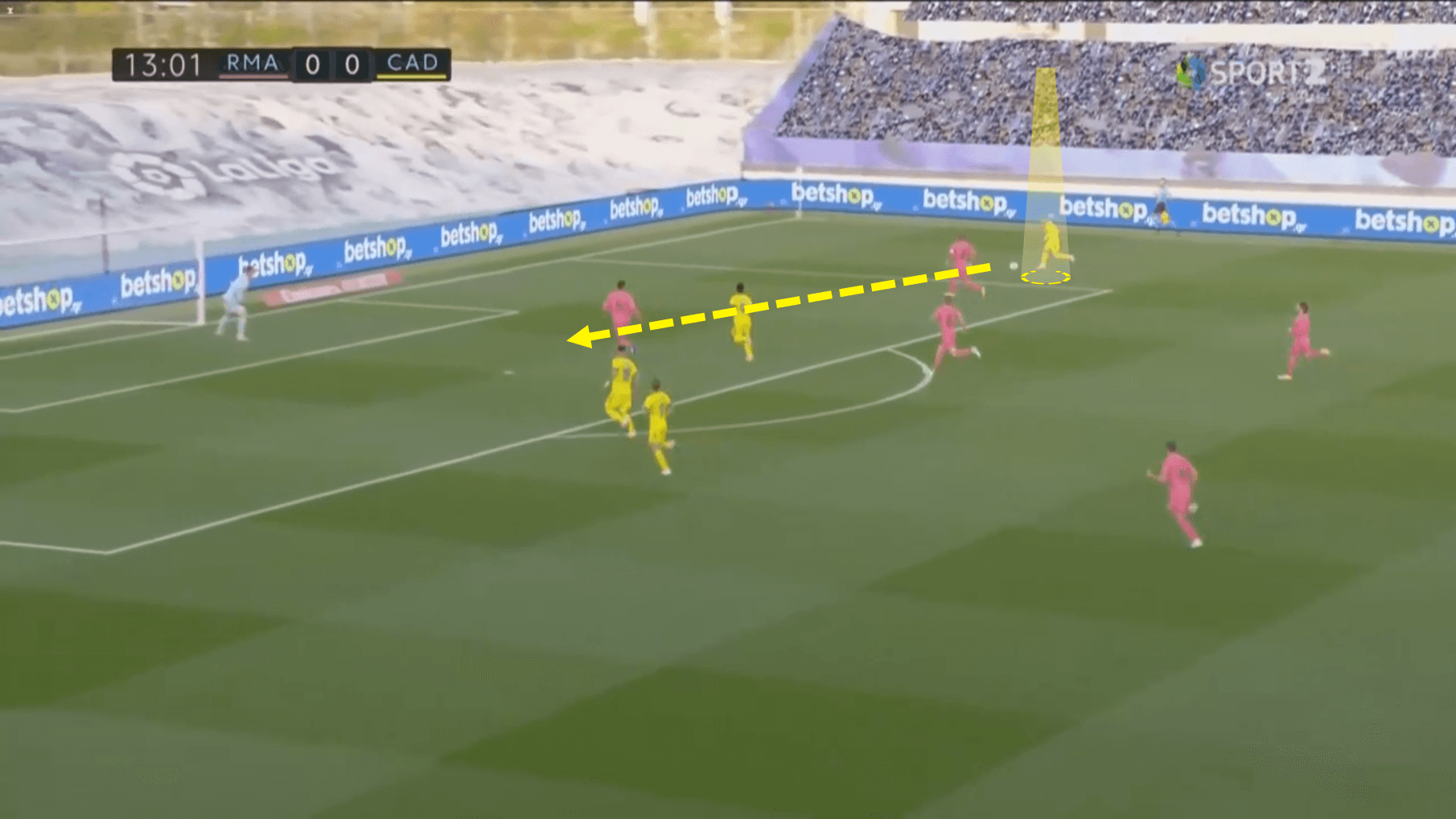
Real Oviedo’s context
After 13 matchweeks of the second-tier of Spain, Alvaro Cervera’s new team sit in the 18th position, winning three matches, one in Cervera’s debut, drawing four and losing six, one recently against Deportivo Alavés in their last match. Only three goals on the goal difference separated them from the relegations spot. So the former Cadiz hero has another big project in front of him to elevate and start an evolution that can surprise many Spanish fans.
The Data Viz shows us what has Real Oviedo been in this early start of the 2022/23 campaign at La Liga Smartbank where they have shown a low ability to create scoring opportunities, but highlighting one of the most important aspects of Cervera’s playing style, lots of crosses are being executed to the box, even though, high-scoring-chances hadn’t appeared at all.
In other terms, we can see that they have been slightly different to how the Spaniard’s sides looked. They are a high pressing team, they recover the ball many times, and they occasionally want to be more in possession of the ball than their rival, but not often. Anyways, this is going to be the kind of thing that is starting to change under Alvaro, and we have started to see that, as their last two games were down in possession features with less than 45% of ball dominance.
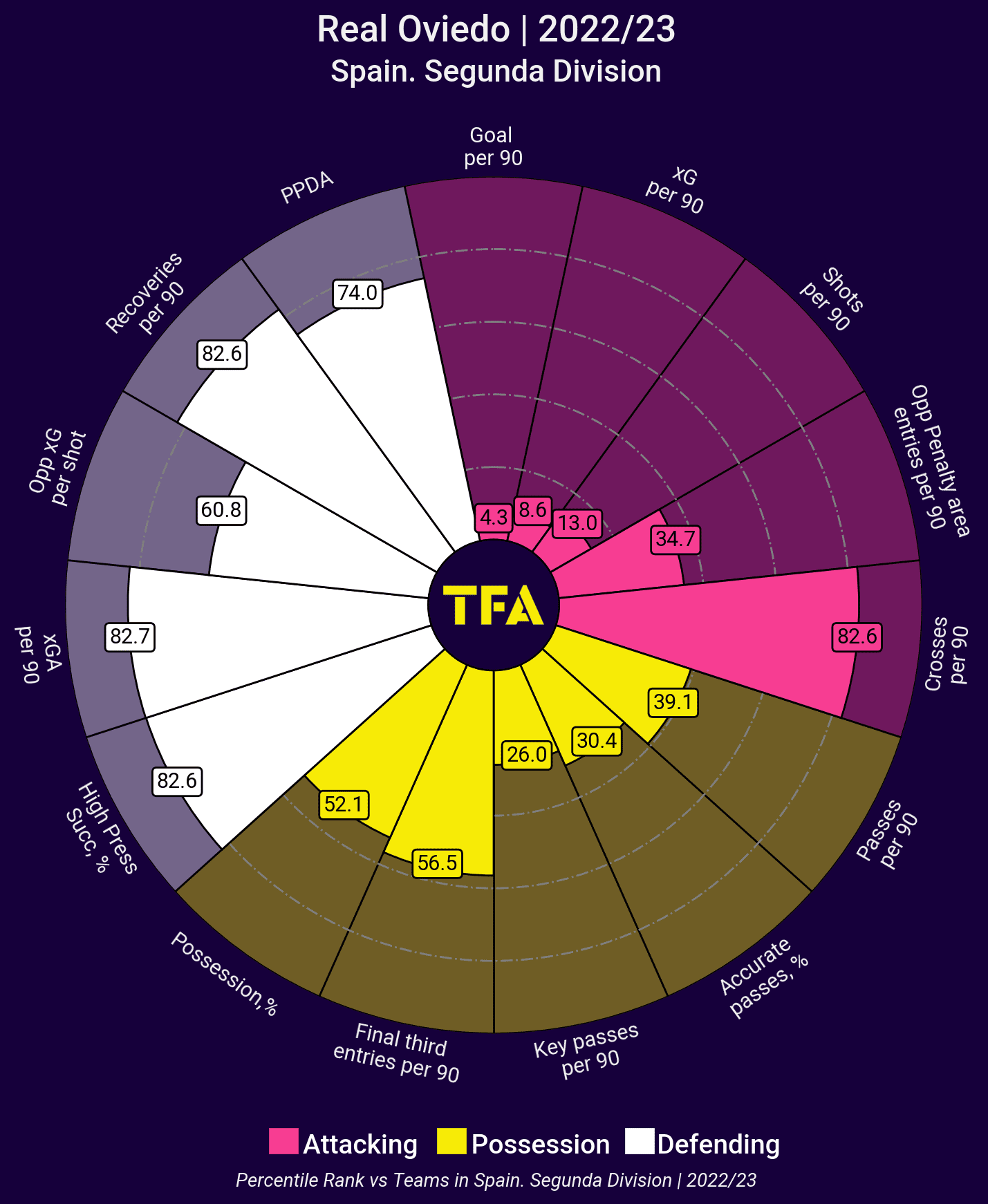
In his first game as Real Oviedo’s head coach, similar things were seen in their approach against Málaga, where they won 1-0 against a really tough side.
Cervera’s new team looked to play in a 4-4-2 with very wide wingers and full-backs, a rigid and strict double-pivot, a striker that looked to be in more contact with the ball, and another being the man looking to run behind the space. The pass map below shows what we are explaining, showing a team in width, a second striker and a very marked midfield.
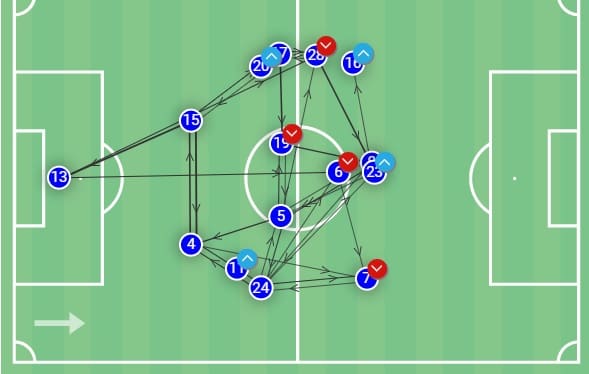
However, things weren’t as equal to what Cadiz showed in their time with ‘El Gafa’, this would obviously take some time and as shown before, Oviedo likes to be a high pressing team. In the match against Málaga, their pragmatic 4-4-2 defensive structure showed a bit of proactivity and aggression that wasn’t that natural at his former teams, looking to suffocate the ball-holder and looking to win the ball back in other heights, as the picture below can show.
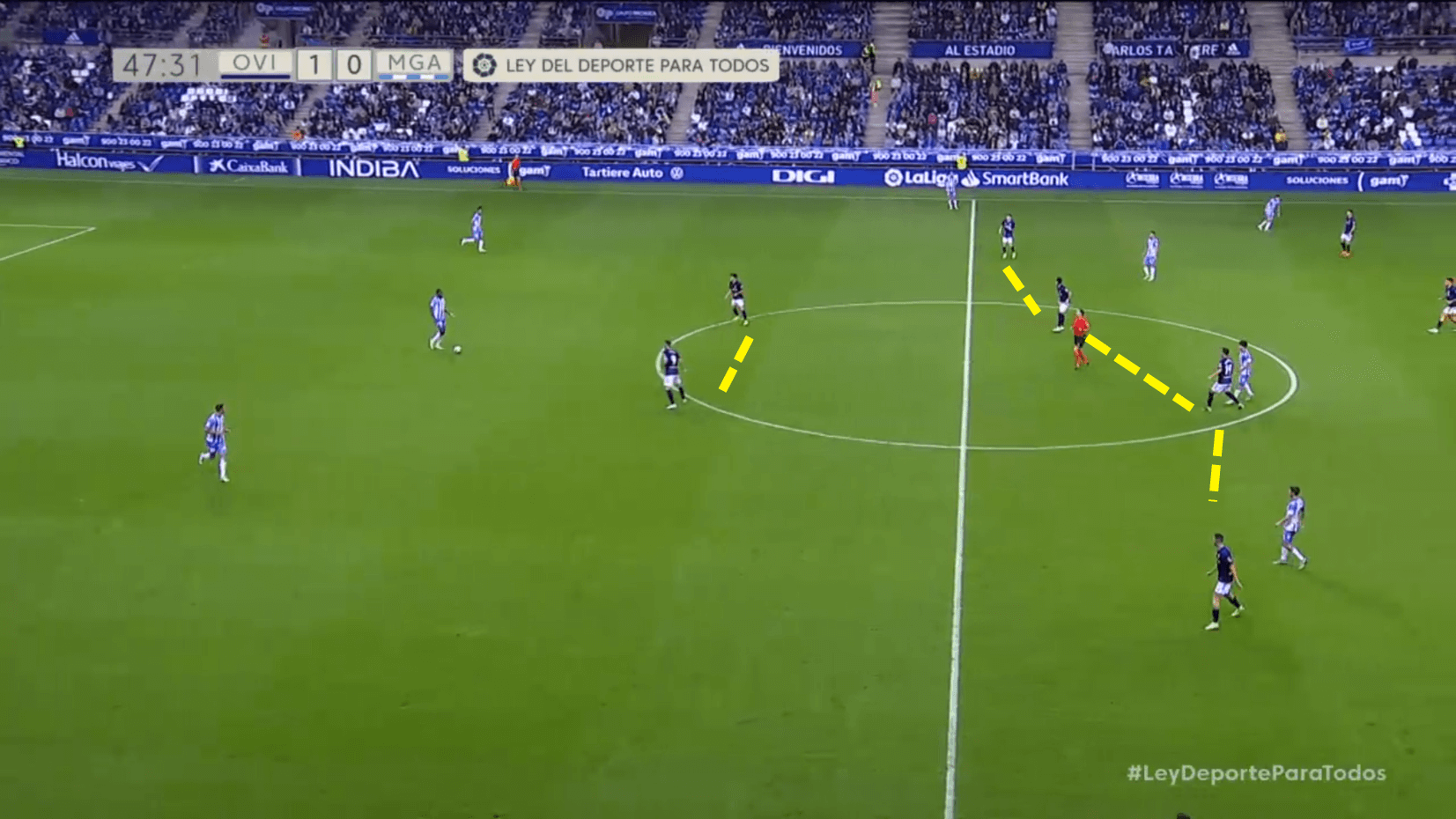
Conclusion
Alvaro Cervera has, season by season, shown his knowledge about the lower categories of Spain, not only with Cadiz but before them with Tenerife, in another of his biggest experiences.
Real Oviedo has been 21 years trying to find a promotion spot that can redefine their history over the last decade. that has passed through the third division as well.
With players like Borja Bastón, Ángel Montoro or Sergi Enrich, Cervera could turn this time into a competitive and committed football team to try and escalate positions in the table to get closer to promotion.
He has recently told the press that the ‘team attitude was very good’ in their recent defeat versus Alavés, so they could be on the right path of their transformation under 57-year-old Cervera.






Comments